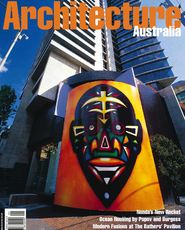 | | From top Kirketon Hotel at Potts Point, Sydney;
Pier One Parkroyal at Walsh Bay, Sydney; Hotel
Lindrum, South Melbourne; Prince Hotel, St Kilda;
Park Hyatt, Melbourne.
| | |

|  |
As the Olympics bubble inflates, new chain and boutique hotels are opening in Sydney and Melbourne – some inserted into elderly buildings and many displaying ‘designer’ interiors.
  | | It doesn’t take long to identify Australia’s achievements in ‘new-wave designer’ hotels since the 1980s. There have been only two establishments worth noting – at least until the current rush of pre-Olympic venues in Sydney and Melbourne.
First, in 1987, the MacMahon family opened Regents Court (D4 Designed with Philippe Starck influences) in Sydney’s Kings Cross. It remains a favourite for travellers in the creative industries, offering large, elegantly furnished suites with kitchens, plus a roof garden. Then in 1993, Denton Corker Marshall opened the Adelphi in Melbourne, generating extensive word-of- mouth about the cutting-edge rooms, convivial sky-lounge and transparently cantilevered roof pool. After a decade of hosting outrageous parties (not least Denton’s own drag-queened 50th birthday several years ago), the Adelphi is for sale. Today, if you want to tell a stylish foreign visitor where to stay, the options are suddenly more diverse.
In Sydney’s Kings Cross, for instance, Regents Court has been joined by two groovy small hotels on the Darlinghurst side of the tunnel, both elderly buildings converted by entrepreneurs Robert and Terry Schwamberg. Their first venture, the Medusa, designed by Scott Weston, is furnished with sizzling, clashing colours which annihilate the idea that hotel rooms should look restful and (in a conventional sense) tasteful. Their latest hotel, The Kirketon, designed by Burley Katon Halliday, reintroduces that ubiquitous 1970s glamour treatment, the mirror, to optically expand and animate the minimally furnished, gloss-painted white restaurant and orange back bar and the dark upstairs hallways.
In central Sydney, two heritage landmarks have been converted to hotels.
At Walsh Bay, the 1912 Pier One wharf has been converted by Crone Associates and Davenport Campbell’s Greg Farrell into a smart, mid-priced Parkroyal. Externally, the shed has some mismatches between the original structure and the new fenestration/ cladding but generally it is a successful update. Internally, the lobby fitout is | | reasonably sensitive to the building’s marine-industrial bones, although the overlaid finishes are, of commercial necessity, sleek and contemporary. The rooms also combine elements of the original structure with new furnishings influenced by Philippe Starck’s mid-1980s fitouts for Beneteau racing yachts.
In Martin Place, the long-abandoned General Post Office, built in the 1870s-80s by Colonial Architect James Barnet, has been transformed into a Westin Hotel, with a soaring atrium, containing cafés and a food emporium, centrally occupied by the skeletal frame of the old postal hall. Key heritage elements, especially the elaborate main staircase, were rebuilt by Clive Lucas Stapleton & Partners. Meanwhile, the Buchan Group topped the Italianate monument with paired towers in a Chicago-classical style that Crones have also used nearby at 2 Park Street and 400 George. In Melbourne, Buchans also designed the six-star Park Hyatt at Cathedral Place: a contemporary-classical podium and tower, with lavish Hollywood Moderne interiors. Melbourne also boasts two new ‘boutique’ hotels converted from old buildings.
In South Melbourne, The Lindrum offers cool, modern luxury within an old tea warehouse converted by Swaney Draper, Terry Fripp and Neil Bradford for developer David Marriner. And on the Acland St corner in St Kilda, the Art Deco Prince of Wales Hotel (now called The Prince) has become a hip complex of diverse pleasures – with 40 guest rooms, the Circa restaurant, a vodka bar, a bakery/café, a wine shop and a live music venue. Architect Allan Powell and interior designer Paul Hecker worked with developers Frank and John van Haandel. All these advances in the architecture of hospitality will further elevate Australia’s international credentials for living well— Davina Jackson |
|




















